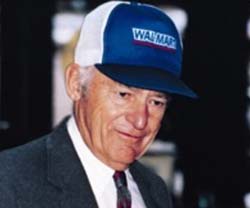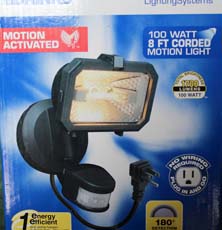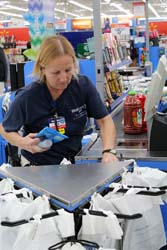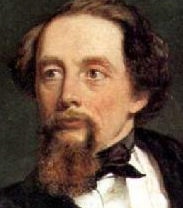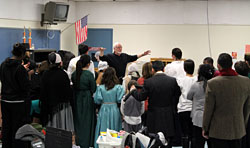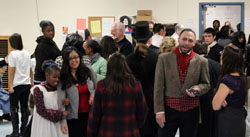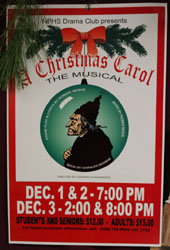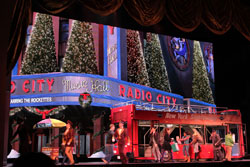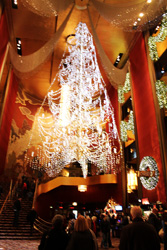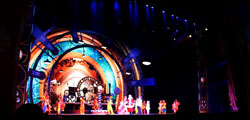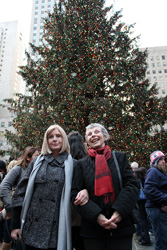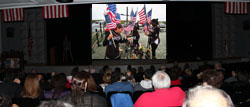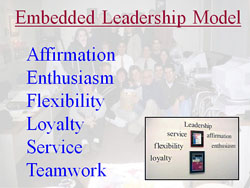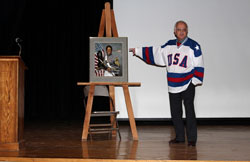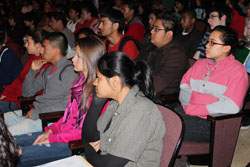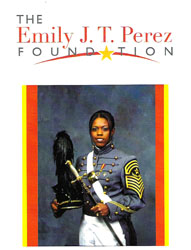Teaching Moments
Written By Tony Mussari
Photographs By Kitch Mussari
Copyright 2011
Mussari-Loftus Associates
The Face of America Project
faceofamericawps.com,
tony.mussari@gmail.com
Teaching Moments
“Nine-tenths of education is encouragement.” Anatole France
Doc 05: the Challenge
Prior to my visit to the North Plainfield High School for two presentations to the student body, I spent many restless nights conceptualizing the nature,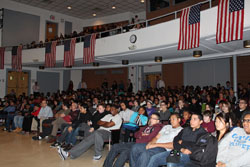 objectives and tone for this unique teaching opportunity.
objectives and tone for this unique teaching opportunity.
I wanted to connect with the students. I wanted to engage the students in a series of exercises that would reinvigorate the seeds of optimism and opportunity planted by their teachers. I wanted to inform the students about the material in our documentary about Shanksville and transformation. I wanted to define the word hero in a way they would not forget. I wanted to leave these students with positive memories about themselves and what they learned.
It was a tall order for a person who is old enough to be their grandfather. It was a challenging for someone who had not spoken to an audience of 500 students in a high school setting in more than 30 years.
For three weeks, I had been thinking, reading, planning and mulling over in my mind what I would say, and how I would say it.
To be very honest, I was somewhat apprehensive about the situation I had gotten myself into, but I was determined to make the best of it.
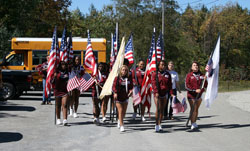
Several things worked to my advantage. I like these students. I admire the educational leaders in their school district. I respect their teachers. I know a good deal about the history and culture of the school district. My wife and I have been here several times, and I taught small groups of students in their classrooms during our visits. I was a guest speaker at two athletic awards banquets, and I recorded a number of public service trips taken by the cheerleaders and their coach Skip Pulcrano.
When the light of discovery and direction finally went on in my mind, it was simple, understandable and very practical. I would do something my mother always encouraged me to do. I would be myself. I would teach in much the same way I taught in my own classroom, from my heart as well as my head. I would apply the information I learned from a teacher at Kent State University: “Effective teaching is as much about good performance as it is about good information.”
Doc 05: the Content
Now that I had a strategy, I could spend time thinking about content, examples and a theme.
The main event for the assembly was a screening of our documentary Shanksville, PA: A Place of Transformation. The film features 12 Cheerleaders from North Plainfield who visited the people’s memorial in Shanksville in 2010 during our Face of America Journey, three Flight 93 Ambassadors who helped us during our ten year What is America? project in Shanksville, the woman who took the only picture of Flight 93’s ending, Val McClatchey and the woman who created the 9/11 National Remembrance Flag, Joanne Galvin.
Shanksville, PA: A Place of Transformation. The film features 12 Cheerleaders from North Plainfield who visited the people’s memorial in Shanksville in 2010 during our Face of America Journey, three Flight 93 Ambassadors who helped us during our ten year What is America? project in Shanksville, the woman who took the only picture of Flight 93’s ending, Val McClatchey and the woman who created the 9/11 National Remembrance Flag, Joanne Galvin.
The film addresses several questions about America at its best, American heroes and American values. It begins with the North Plainfield High School Concert Band playing Flight of Valor. It ends with a montage of images summarizing the events of September 11, to the music of Jo Ann Biviano’s I’ll Always Remember.
This screening provided an excellent opportunity to talk about the person who 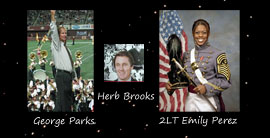 inspired our Face of America Journey, 2LT Emily Perez, the first Black/Hispanic honors graduate to lose her life in Iraq. I could tie Emily’s Legacy into the life work of another inspirational American, Professor George N. Parks, the teacher who built a national reputation for the Minuteman Marching Band at the University of Massachusetts. His work with students could be linked with another motivational teacher and coach, Herb Brooks and his 1980 U.S. Olympic Hockey team.
inspired our Face of America Journey, 2LT Emily Perez, the first Black/Hispanic honors graduate to lose her life in Iraq. I could tie Emily’s Legacy into the life work of another inspirational American, Professor George N. Parks, the teacher who built a national reputation for the Minuteman Marching Band at the University of Massachusetts. His work with students could be linked with another motivational teacher and coach, Herb Brooks and his 1980 U.S. Olympic Hockey team.
The documentary films Kitch and I produced about Coach Brooks and Professor Parks and the short films we edited about Emily Perez, gave me all the material I needed to tell their stores in what I hoped would be a compelling and interesting way to the students in North Plainfield.
The narratives of each of these American heroes gave me an opportunity to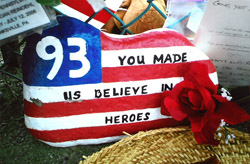 address the question, What is a hero? I could make the significant distinction between a hero and a celebrity. That would open the door to the matter I wanted to emphasize for the students, the impressive examples of industry and service Kitch and I found in North Plainfield, the genuine goodness of this place and the radiant Face of America it projects.
address the question, What is a hero? I could make the significant distinction between a hero and a celebrity. That would open the door to the matter I wanted to emphasize for the students, the impressive examples of industry and service Kitch and I found in North Plainfield, the genuine goodness of this place and the radiant Face of America it projects.
Doc 05: The Moment
The first assembly began sometime after 9 a.m. on a beautiful Monday 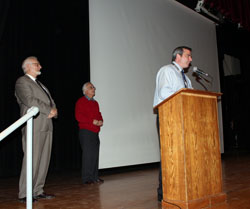 morning. After introductions by the principal, Jerard Stevenson and the Supervisor of Fine Arts, Tom Mazur, I climbed the steps to the stage. Standing behind the podium, I waited for a few seconds, and then I enthusiastically greeted the students.
morning. After introductions by the principal, Jerard Stevenson and the Supervisor of Fine Arts, Tom Mazur, I climbed the steps to the stage. Standing behind the podium, I waited for a few seconds, and then I enthusiastically greeted the students.
They responded and we were off to a very good start.
After a few moments, I made a costume change.
The year I retired from teaching, Kitch and I worked with twenty students on a documentary project about the 25th anniversary of the Miracle on Ice. It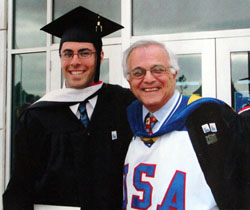 was designed to teach the students life lessons and work values by studying Coach Herb Brooks and the 1980 U.S. Olympic Hockey Team. During my final night as a teacher, the students gave me what they called a “Miracle Shirt.” It is one of my most treasured possessions. I wore it under my academic gown at graduation and one other time during a guest lecturer at St. Mary’s College in Moraga California.
was designed to teach the students life lessons and work values by studying Coach Herb Brooks and the 1980 U.S. Olympic Hockey Team. During my final night as a teacher, the students gave me what they called a “Miracle Shirt.” It is one of my most treasured possessions. I wore it under my academic gown at graduation and one other time during a guest lecturer at St. Mary’s College in Moraga California.
I explained the importance of the shirt, and its symbolism. Then, I walked to the easel next to the podium. I removed the shirt uncovering a framed picture of a smiling Emily Perez. Just before I put the shirt on, I told the students I was going to wear this shirt for the third time to honor them. The comment resonated with the audience.
For the next few minutes we did some exercises that got the students out of 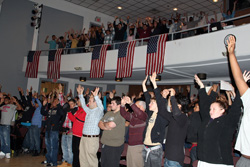 their seats and enabled them to have some fun, learn some lessons about life, success, coping with disappointment, pursuing excellence and accepting themselves.
their seats and enabled them to have some fun, learn some lessons about life, success, coping with disappointment, pursuing excellence and accepting themselves.
Whatever I asked the students to do they did with zest and involvement. It was such a joyful experience. We were working together, learning together, celebrating together and having a good time together.
To be honest, it felt good to be in a classroom with so many students who were enthusiastically participating.
My segue to the film was a short story about Emily Perez: her background; her accomplishments in the classroom, on the athletic field and her impressive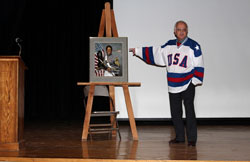 record of selfless service to others. I compared her courage and heroism to the actions of the heroes of flight 93. I asked the students to watch the film with their hearts as well as their eyes. I asked them to listen with their ears and their hearts to the things their classmates would say about their hopes, their dreams and their country.
record of selfless service to others. I compared her courage and heroism to the actions of the heroes of flight 93. I asked the students to watch the film with their hearts as well as their eyes. I asked them to listen with their ears and their hearts to the things their classmates would say about their hopes, their dreams and their country.
The room grew silent, the lights went out and the film began. I made my way to the back of the auditorium. My heart was pumping in overdrive, and my spirits were about as high as the azure blue sky above. It was one of the best teaching opportunities of my lifetime.
In my heart of hearts, I believed that I connected with the students. I did what I came here to do. I reinforced my strong belief that this is a place where one finds the Face of America’s tomorrow today.
When the film ended, I had a few moments with the students, and then they 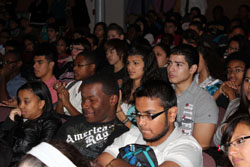 left the auditorium to attend their regularly scheduled classes. As they filed out of the room, several students offered encouraging comments about their experience. When I was about to leave, I was greeted by a substitute teacher who, with tears in her eyes, hugged me and expressed her thanks.
left the auditorium to attend their regularly scheduled classes. As they filed out of the room, several students offered encouraging comments about their experience. When I was about to leave, I was greeted by a substitute teacher who, with tears in her eyes, hugged me and expressed her thanks.
Later in the day she wrote these words:
I wanted to thank you once again for all your incredible dedication and work in such a necessary area, that of reaffirming the goodness of our wonderful country and its young people, and that of honoring our fallen.
I cannot begin to describe to you how profound and cathartic an effect your work had upon me. I felt certain that I had composed myself long prior to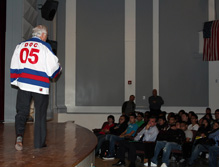 approaching you, yet upon our handshake I felt this overwhelming wave of emotion come back over me. Call it gratitude, call it inspiration, respect, etc. but I was very shocked at the depth and range of feelings I experienced.
approaching you, yet upon our handshake I felt this overwhelming wave of emotion come back over me. Call it gratitude, call it inspiration, respect, etc. but I was very shocked at the depth and range of feelings I experienced.
I feel your documentary does exactly what any great documentary is supposed to do: it informs and extols while getting people to think and REACT to what they are learning. I can’t call it anything less than a spiritual experience.
It definitely has everything to do with the fact that I am so very proud of my brother, a current civilian private contractor, post-military officer who was presented a bronze medal and now works actively in the wage for peace in counter-terrorism intelligence.
Please take my words with you as an additional level of affirmation and inspiration that you and your wife so richly deserve, as you have inspired so many.
God has Blessed You, Dr. Mussari and your lovely wife… may your work never stop moving forward to inspire everyone
On Tuesday morning at 8:30 we returned to the auditorium for another 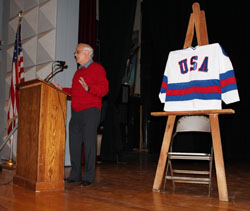 assembly. It was a memorable beginning to a very long day that would culminate in a public screening at 7:00 p.m.
assembly. It was a memorable beginning to a very long day that would culminate in a public screening at 7:00 p.m.
Throughout the day two thoughts reverberated in my mind:
The best teachers teach from the heart, not from the book. Author Unknown
It’s not what is poured into a student that counts, but what is planted. Linda Conway
Thank You, Tom Mazur.
Thank you, Skip Pulcrano.
Thank You, Jerard Stephenson.
Thank You, Marilyn Birnbaum.
Thank you, North Plainfield students for giving an old teacher a new classroom and memories that will last a lifetime.
Tony & Kitch Mussari
Producers
The Face of America Project
Please provide feedback to:
tony.mussari@gmail.com
 Lumber shortly after noon on an unseasonably warm January day. My mission was simple. I was looking for a package of roofing nails. I needed them to make a temporary repair to a section of our roof that was damaged during the fall storms that devastated parts of Northeastern Pennsylvania.
Lumber shortly after noon on an unseasonably warm January day. My mission was simple. I was looking for a package of roofing nails. I needed them to make a temporary repair to a section of our roof that was damaged during the fall storms that devastated parts of Northeastern Pennsylvania.
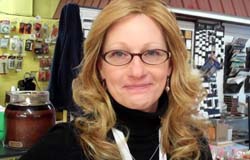 employee, Holly Berry, who had just learned that her treatment for breast cancer was officially over.
employee, Holly Berry, who had just learned that her treatment for breast cancer was officially over.
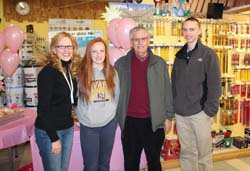 children. Her dad is a distinguished looking man whose face bears the scars left by the premature loss of his wife to breast cancer and the anxiety ridden months of his daughter’s battle with breast cancer.
children. Her dad is a distinguished looking man whose face bears the scars left by the premature loss of his wife to breast cancer and the anxiety ridden months of his daughter’s battle with breast cancer.
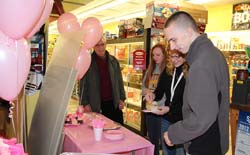 day. She personifies the kind of courage, determination and value based-leadership that cancer patients need to survive. She is optimistic about her future, and she is going to make the best of whatever she will encounter. She is not angry. She does not feel sorry for herself, and she does not lament what has happened to her.
day. She personifies the kind of courage, determination and value based-leadership that cancer patients need to survive. She is optimistic about her future, and she is going to make the best of whatever she will encounter. She is not angry. She does not feel sorry for herself, and she does not lament what has happened to her.

